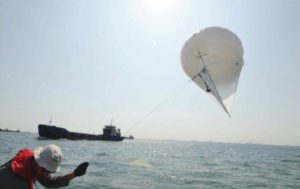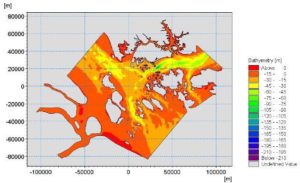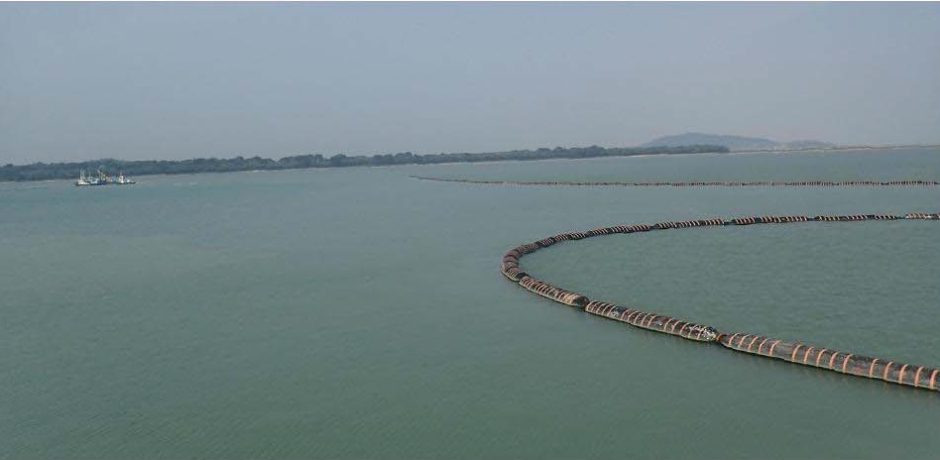Our Blog
PROJECT OVERVIEW
Singapore has one of the busiest sea ports in the world. Located at the crossroads of many m ajor shipping routes, Singapore is a focal point of some 400 shipping lines with links to more than 700 ports around the world. Given much of its territorial waters are dedicated to marine use, there are limits to how much land Singapore can reclaim.
ajor shipping routes, Singapore is a focal point of some 400 shipping lines with links to more than 700 ports around the world. Given much of its territorial waters are dedicated to marine use, there are limits to how much land Singapore can reclaim.
Two new reclamation projects were recently launched at Pulau Tekong and Tuas View Extension. As these large scale projects were being carried out, Malaysia alleged that the works were having an adverse impact on their territorial waters. Singapore’s ongoing reclamation works were subject to consideration by the International Tribunal for the Law of the Sea on the grounds that they were causing trans boundary environmental harm. In the resolution paper it was determined that the works were not having the adverse impacts as claimed, but that strict monitoring needed to be undertaken to ensure this remained the case.
The use of 3D hydrodynamic and sediment plume modelling is considered international best practice and was used as the benchmark for all WorleyParsons modelling. Three dimensional hydrodynamic numerical modelling of sediment plumes underpins the scientific assessment of potential impact from dredging and sediment disposalactivities. WorleyParsons developed a front and backend system, called Neptune, to pro-actively manage any marine construction activities using sophisticated hydrodynamic models. This groundbreaking initiative to monitor all of Singapore’s territorial waters in 3D every hour in near-real-time is a global first and utilises a cutting-edge algorithm. Harnessing the power of satellite technology and cloud computing, WorleyParsons can identify where construction-related plumes or altered currents are affecting environmental receptors including in this case, at the Singapore/Malaysian boundary. The Neptune facility means that data that would previously have taken years to process can now be viewed and analysed in a matter of seconds and government officials can now see where plumes are crossing the border (in 3D in near-real-time), or can even receive automatic alerts when this occurs to enable impacting activities to be stopped before more damage is done.
hydrodynamic numerical modelling of sediment plumes underpins the scientific assessment of potential impact from dredging and sediment disposalactivities. WorleyParsons developed a front and backend system, called Neptune, to pro-actively manage any marine construction activities using sophisticated hydrodynamic models. This groundbreaking initiative to monitor all of Singapore’s territorial waters in 3D every hour in near-real-time is a global first and utilises a cutting-edge algorithm. Harnessing the power of satellite technology and cloud computing, WorleyParsons can identify where construction-related plumes or altered currents are affecting environmental receptors including in this case, at the Singapore/Malaysian boundary. The Neptune facility means that data that would previously have taken years to process can now be viewed and analysed in a matter of seconds and government officials can now see where plumes are crossing the border (in 3D in near-real-time), or can even receive automatic alerts when this occurs to enable impacting activities to be stopped before more damage is done.
SIGNIFICANT ASPECTS
While Singapore has utilised 2D modelling and huge field-based monitoring programs for the past 10 years, WorleyParsons recognised there was an opportunity for improvement and that they needed to be technically innovative in order to break into the market and deliver.
From its Centre of Excellence for Marine Sciences based in Perth, the firm created a solution that required development of complex hydrodynamic models, procedures for updating the spill budget and a quality control algorithm that rejected data sent by third parties if it did not meeton live telemetry information infield. The boundary issues also mean that there was extreme sensitivity around the project works.
As Singapore’s ongoing reclamation works were summoned to the International Tribunal for the Law of the Sea, WorleyParsons developed modelling solutions to proactively enable construction to continue, ensuring real time results and efficient monitoring.
The solutions included:
• Daily model hindcast
• Daily forecast analysis
• Daily satellite imaqery analysis
• Acoustic ADCPs
• Reports on the tonnage spilt daily, setting the nex t 48 hours’ spill budget.
All this was undertaken automatically through WorleyParsons’ Neptune platform- coupling together a complicated modelling, cloud computing and validation program-and using the technology in innovative ways. WorleyParsons was able to deliver daily reports within 24 hours to proactively manage the results from the dredge-related impacts while helping to save approximately 50 per cent in costs compared to other tender prices. This ambitious and innovative monitoring program helps overcome the ocean information challenge and gives users the power to protect environmentalquality objectives before adverse impacts can occur. Neptune allows governments to respond quickly to incidents, marine contractors to have more control over their construction process,and academics, NGOs, the media and the pulblic due to the wealth of information.
Comments ( 372 )
The comments are now closed.



blaze pizza keto https://ketodietione.com/
gay oriental dating https://gaychatus.com/
onegoodlove gay dating https://gaydatingzz.com/
mont belvieu tx gay dating https://gaychatrooms.org/
bro gay dating site https://gaychatgay.com/
gay dating no charge https://freegaychatnew.com/
gay daddy dating site https://gaydatingcanada.com/
gay prisoner dating https://gayonlinedating.net/
gay dating free usa https://gayedating.com/
gay best paid dating https://gaydatinglosangeles.com/
gay dating radar site https://gay-singles-dating.com/
gay master slave dating sites https://datinggayservices.com/
writing an essay online https://essayghostwriter.com/
website that writes essays https://essaywritercentral.com/
writing an essay introduction https://essaytag.com/
write a essay https://essaypoints.com/
best custom essay writing service https://essaysnet.com/
writing essays services https://onlinecasinos4me.com/
writing good essay https://online2casino.com/
real money casino https://casinosonlinex.com/
american online casinos https://onlinecasinoad.com/
online real money casino https://casinoonlinet.com/
help me write my essay https://buy1essay.com/
writing essay for college https://dollaressays.com/
writing an expository essay https://multiessay.com/
writing experience essay https://student-essay.com/
[…] cheap viagra 100mg […]
[…] roulette in vegas […]
cialis mg
cialis mg
sex games sites https://cybersexgames.net/
cialis without prescription
cialis without prescription
viagra patent expiration
viagra patent expiration
free downloading sex games https://winsexgames.com/
best sex games download https://sex4games.com/
[…] viagra pfizer 100 mg online […]
[…] cialis brand 5 mg […]
[…] sildenafil 100 mg ebay […]
3lateness
tadalafil generic usa
tadalafil generic usa
gay dating site: bluee https://gaypridee.com
gay dating advice – dating a much younger man or 18 yr old in high school https://gay-buddies.com
gay dating discord https://gayprideusa.com
dating sites without gay or trans https://speedgaydate.com
names.of gay dating sites https://gayfade.com
dating for older gay men https://gaysugardaddydatingsites.com
zithromax
zithromax
viagra com
viagra com
[…] online blackjack american express […]
[…] what are cialis pills used for […]
[…] viagra generic 75mg […]
black bottom gay chat https://bjsgaychatroom.info/
gay dating us marine https://gaypridee.com/
gay sex chat no registration https://gaytgpost.com/
gay chat pittsburgh https://gay-buddies.com/
[…] cialis daily use […]
dating sites for hiv black men gay https://speedgaydate.com/
cialis website coupon
cialis website coupon
[…] buygenericcialisonline conto pl buy cialis html […]
sildenafil tadalafil
sildenafil tadalafil
[…] what are sildenafil tablets […]
[…] viagra sale toronto […]
mobic medication vs meloxicam
mobic medication vs meloxicam
ivermectin otc
ivermectin 18mg
stromectol price
ivermectin buy nz
cheap cialis
online cialis us
viagra from canada
viagra tablets uk
generic viagra prescription
generic viagra for women
ivermectine
ivermectin cream cost
ivermectin ebay
flccc ivermectin
ventolin drug
ventolin hfa price
masks
flccc ivermectin
free casino slots games https://2-free-slots.com/
where can i buy ivectermin
flccc protocol
yahoo slots farm https://freeonlneslotmachine.com/
sun
free slots vegas https://pennyslotmachines.org/
real casino free slots https://slotmachinesworld.com/
how to get ivermectina
flccc ivermectin
ivermectin oral solution
ivermectin 500ml
stromectol buy uk
stromectol ivermectin
ivermectin 0.5 lotion india
stromectol tab price
stromectol usa
ivermectin 5 mg
ivermectin 3mg dose
ivermectin 9 mg tablet
ivermectin humans
ivermectin 50ml
ivermectin over the counter uk
ivermectin malaria
ivermectin 4
stromectol liquid
ivermectin uk
ivermectin where to buy
ivermectin cost
ivermectin tablets for humans
lincoln slots online https://slotmachinesforum.net/
purchase ivermectin
stromectol for sale
ivermectin in india
ivermectin kaufen
double diamond free slots https://slot-machine-sale.com/
where can i buy ivermectin
buy stromectol
las vegas slots for free https://beat-slot-machines.com/
[…] cheap viagra tablets […]
brian christopher slots https://download-slot-machines.com/
free slots cleopatra https://411slotmachine.com/
free slots casino https://www-slotmachines.com/
ivermectin where to buy
ivermectin australia
ignition casino in australia
ignition casino in the us
dnd level 6 spell slots https://slotmachinegameinfo.com/
ivermectin ontario
ivermectin in canada
generic for cialis
tadalafil otc
order prednisone 20mg sale
buy prednisone 5mg generic
cheap generic cialis from india
cialis australia
generic tadalafil
best price for tadalafil
cephalon provigil online
provigil online
buy ivermectin pills
stromectol usa
ivermectin brand name
stromectol order
ivermectin tablets for sale
ivermectin generic
viagra by mail order from canada
viagra kaufen
cialis generic
can you buy cialis in canada
cialis generic medication
cialis tadalafil tablets
discount viagra online canada
buy sildenafil in canada
tadalafil dosage recommendations
tadalafil dosage recommendations
furosemide 40 mg diuretic
how to get lasix without a prescription
where to buy lasix
buy furosemide online usa
ivermectin 2
ivermectin pyrantel pamoate
generic for cialis
tadalafil online purchase
phd dissertation https://buydissertationhelp.com/
cialis generic cialis for sale
sildenafil citrate
buy real cialis cheap
brand cialis in canada
how to buy cialis in canada
tadalafil sale
nursing dissertation help https://dissertationwriting-service.com/
sildenafil tablets uk
real sildenafil pills online
dissertation help tutors https://help-with-dissertations.com/
tadalafil research liquid
generic cialis online purchase
writing dissertation proposal https://mydissertationwritinghelp.com/
dissertation acknowledgement sample https://dissertations-writing.org/
help me with my dissertation https://helpon-doctoral-dissertations.net/
cialis with prescription
no prescription cialis canada
ivermectin 0.5% brand name
ivermectin medication
generic sildenafil pills
cheap sildenafil 100mg
where can you buy sildenafil pills
buy sildenafil pills from canada
buy viagra online
buy viagra online
cialis bula
cheapest online generic cialis
where can i get cialis over the counter
generic tadalafil
weaning off prednisone 20mg
does prednisone 20mg pill look like
uses of prednisone 20mg
how to buy prednisone online
cialis online no prescription
generic cialis online no prescription
merck covid pill side effects
merck covid drug
tadalafil prescription drug prices
how to get cialis prescription
buy online
buying cialis
buy cialis over the counter
cialis generic medication
viagra cialis
generic cialis drugs
ivermectin paste
stromectol 3 mg tablet
generic viagra tablets
generic viagra online pharmacy
steroid side effects
side effects for prednisone
generic
tadalafil cialis
online gambling sites real money
free online games that pay real money
viagra buy online
viagra canada purchase
where to purchase sildenafil
generic viagra us
tadalafil cost walgreens
can i buy cialis over the counter at walgreens
borgata ac
nj online casino borgata
generic
cialis super active
where to buy ivermectin for humans
ivermectin 10 ml
stromectol pill
stromectol ireland
online gambling free bonus no deposit
casinos online for real money top rated
can i buy generic cialis
buying cialis
accutane tablets price in pakistan
average cost of accutane with insurance
cialis 20mg online
tadalafil liquid
where can i buy viagra over the counter in usa
how to purchase viagra pills
zithromax medscape
zithromax medscape
tadalafil liquid
cialis super active
ciprofloxacin ribosomal
ciprofloxacin ribosomal
augmentin suspension
augmentin suspension
zithromax globalrph
zithromax globalrph
ivermectin tablets over counter
ivermectin pills for people
cheap cialis without prescription
buy tadalafil without prescription
best online casino
win casino online
ivermectin study
stromectol tablete cena
ivermectin lotion
stromectol tablets for humans
tadalafil prescription cost
cialis 5mg no prescription
mectin ivermectin
ivermectin 50
ivermectin history
purchase ivermectin
chloromycetin
chloromycetin
ivermectine
where to buy stromectol online
ciprofloxacin iron
ciprofloxacin iron
cephalexin ckd
cephalexin ckd
buy stromectol pills
ivermectin virus
antibiotic zithromax
antibiotic zithromax
erythromycin obstetrics
erythromycin obstetrics
cephalexin used
cephalexin used
is celebrex safe
is celebrex safe
ivermectin oral solution
ivermectin trial
ivermectin buy online
how to get ivermectin
tadalafil medication
generic for cialis tadalafil
furosemide 40 mg buy online
furosemide 80 mg daily
how much is furosemide
furosemide tablets for sale uk
ivermectin overdose
where to buy ivermectin online
stromectol buy
ivermectin ken
ivermectin virus
ivermectina piojos
ivermectin without prescription
stromectol ivermectin tablets
where can i buy ivermectin
stromectol 3 mg tablet
stromectol coronavirus
ivermectin 0.1
luckyland slot
lucky land slots.com
push health ivermectin
ivermectin oral solution
ivermectin horse paste for humans
what is ivermectin used for
stromectol tablet 3 mg
ivermectin dr pierre kory
stromectol cvs
buy ivermectin cream for humans
stromectol covid
iwermektyna
ivermectin topical
where to purchase ivermectin
ivermectin paste
use of ivermectin
ivermectin 12
stromectol ebay
invermectin
ivermectin 3 mg tablet dosage
stromectol tab price
ivermectin tablet
canada drug cialis
tadalafil
stromectol tablets for humans for sale
stromectol preis
where can you buy ivermectin
stromectol tablete
what is ivermectin used for humans
dexis ivermectin
stromectol how much it cost
ivermectin for gapeworm
3almanac
ivermectin 24 mg
ivermectin 24 mg
generic ivermectin cream
iver mectin
ivermectin pills human
ivermectin brand name
1gaslight
dissertation defense https://professionaldissertationwriting.org/
dissertation examples https://professionaldissertationwriting.com/
viagra
viagra
writing dissertation and grant proposals https://helpwithdissertationwritinglondon.com/
dissertation writing assistance https://dissertationwritingcenter.com/
buy dissertation online https://dissertationhelpexpert.com/
help with dissertation topic https://accountingdissertationhelp.com/
dissertation paper writing service https://examplesofdissertation.com/
dissertation writing process https://writing-a-dissertation.net/
masters dissertation help https://bestdissertationwritingservice.net/
sildenafil citrate
sildenafil citrate
help with dissertation topic https://businessdissertationhelp.com/
books and dissertation about mafa people https://customdissertationwritinghelp.com/
phd thesis https://writingadissertationproposal.com/
writing a dissertation literature review https://dissertationhelpspecialist.com/
tips for writing dissertation https://dissertationhelperhub.com/
masters dissertation writing services uk https://customthesiswritingservices.com/
revatio
revatio
viagra generic
viagra generic
online casino nj https://download-casino-slots.com/
online casino live roulette https://firstonlinecasino.org/
online casino deutschland https://onlinecasinofortunes.com/
wynn casino online https://newlasvegascasinos.com/
best real money casino online https://trust-online-casino.com/
online casino usa real money xb777 https://onlinecasinosdirectory.org/
online casino free bet no deposit https://9lineslotscasino.com/
pala casino online nj https://free-online-casinos.net/
online casino real money no deposit bonus https://internet-casinos-online.net/
best nj online casino https://cybertimeonlinecasino.com/
free online casino no deposit https://1freeslotscasino.com/
ocean online casino login https://vrgamescasino.com/
lucky dragon casino online https://casino-online-roulette.com/
zone online casino vegas world https://casino-online-jackpot.com/
casino online nj https://onlineplayerscasino.com/
betmgm online casino nj https://ownonlinecasino.com/
real casino games online https://all-online-casino-games.com/
real casino online https://casino8online.com/
avast vpn buy https://freevpnconnection.com/
top 10 vpn services https://shiva-vpn.com/
free vpn usa https://freehostingvpn.com/
free vpn for macbook https://ippowervpn.net/
hola free vpn https://imfreevpn.net/
best vpn to use in china https://superfreevpn.net/
best vpn for binance https://free-vpn-proxy.com/
browsec vpn https://rsvpnorthvalley.com/
plenty fish date site https://freephotodating.com/
farmers only dating https://onlinedatingbabes.com/
dating gmail germany https://adult-singles-online-dating.com/
local dating https://adult-classifieds-online-dating.com/
dating free site https://online-internet-dating.net/
meet online service https://speedatingwebsites.com/
online dating meet https://datingpersonalsonline.com/
online free dating site https://wowdatingsites.com/
pof dating https://lavaonlinedating.com/
free single dating online https://freeadultdatingpasses.com/
dating club https://virtual-online-dating-service.com/
local online dating https://zonlinedating.com/
best free online meeting sites https://onlinedatingservicesecrets.com/
gun lake casino online https://onlinecasinos4me.com/
online vegas casino https://online2casino.com/
borgata online casino app https://casinosonlinex.com/
free asian gay chat lines https://newgaychat.com/
older gay video chat https://gaychatcams.net/
zoom chat gay https://gaychatspots.com/
phone chat in maryland gay https://gay-live-chat.net/
gay roulette chat https://chatcongays.com/
gay connect chat https://gayphillychat.com/
gay chat lines https://gaychatnorules.com/
gay chat washington state https://gaymusclechatrooms.com/
mature gay chat app https://free-gay-sex-chat.com/
free gay chat rooms in ioq https://gayinteracialchat.com/
online gay chat rooms https://gaymanchatrooms.com/
can someone write my paper for me https://term-paper-help.org/
someone to write my paper for me https://sociologypapershelp.com/
where can i find someone to write my paper https://uktermpaperwriters.com/
best custom paper writing service https://paperwritinghq.com/
professional paper writer https://writepapersformoney.com/
help with writing paper https://write-my-paper-for-me.org/
custom writing papers https://doyourpapersonline.com/
paying someone to write a paper https://top100custompapernapkins.com/
buy papers for college https://researchpaperswriting.org/
where can you buy resume paper https://cheapcustompaper.org/
pay to write paper https://writingpaperservice.net/
professional college paper writers https://buyessaypaperz.com/
write my statistics paper https://mypaperwritinghelp.com/
english paper help https://writemypaperquick.com/
pay someone to write your paper https://essaybuypaper.com/
professional college paper writers https://papercranewritingservices.com/
pay someone to write a paper https://premiumpapershelp.com/
can someone write my paper for me https://ypaywallpapers.com/
psychology paper writing service https://studentpaperhelp.com/
propecia merck online
propecia nz buy
buy propecia online hong kong
buy cheap propecia tablets
3beijing
2clothes
database coursework https://brainycoursework.com/
coursework science https://brainycoursework.com/
coursework moderation https://courseworkninja.com/
coursework writing service uk https://courseworkninja.com/
design and technology gcse coursework https://writingacoursework.com/
online coursework https://writingacoursework.com/
coursework writing services https://mycourseworkhelp.net/
coursework only degree https://mycourseworkhelp.net/
design and technology gcse coursework https://courseworkdownloads.com/
coursework https://courseworkdownloads.com/
data analysis coursework https://courseworkinfotest.com/
coursework planner https://courseworkinfotest.com/
coursework help uk https://coursework-expert.com/
data analysis coursework https://coursework-expert.com/
design technology coursework https://teachingcoursework.com/
coursework plagiarism checker https://teachingcoursework.com/
coursework writing https://buycoursework.org/
differential equations coursework https://buycoursework.org/
coursework paper https://courseworkdomau.com/
coursework writing service uk https://courseworkdomau.com/
professional dating sites https://freewebdating.net/
match single https://freewebdating.net/
flirt dating site https://jewish-dating-online.net/
good dating sites https://jewish-dating-online.net/
sz dating seiten https://jewish-dating-online.net/
dating sifes https://jewish-dating-online.net/
dating web https://free-dating-sites-free-personals.com/
free women dating https://free-dating-sites-free-personals.com/
christian singles dating site https://sexanddatingonline.com/
date free site https://sexanddatingonline.com/
romancemingle https://onlinedatingsurvey.com/
single website https://onlinedatingsurvey.com/
women for free https://onlinedatingsuccessguide.com/
dating app https://onlinedatingsuccessguide.com/
adult dating https://onlinedatinghunks.com/
meet online https://onlinedatinghunks.com/
single senior dating sites https://datingwebsiteshopper.com/
dating sites adult https://datingwebsiteshopper.com/
date match site https://allaboutdatingsites.com/
dating sites nl https://allaboutdatingsites.com/
date sites free https://freedatinglive.com/
free online chat and dating sites https://freedatinglive.com/
free adult dating sites https://freewebdating.net/
dating for free https://freewebdating.net/
write my essay custom writing
services write my essay custom writing movie reviews,..
… [Trackback]
[…] Read More: diverless.org/land-reclamation-case-malaysia-verse-singapore/ […]
best blog comment service
ttacwghlt ecmoi kkjlopz wprj ifkvgfflvihebxi
what is the best custom essay writing service
Land Reclamation Case – Malaysia Verse Singapore | Diverless
viagra canada no prescription
Land Reclamation Case – Malaysia Verse Singapore | Diverless
[…] clindamicina gel acné[…]
clindamicina gel acné
essay writer software
Land Reclamation Case – Malaysia Verse Singapore | Diverless
essay help live chat
Land Reclamation Case – Malaysia Verse Singapore | Diverless
good essay writing websites
Land Reclamation Case – Malaysia Verse Singapore | Diverless
what should i write my essay on
Land Reclamation Case – Malaysia Verse Singapore | Diverless
cheap essay writer
Land Reclamation Case – Malaysia Verse Singapore | Diverless
good essay writing website
Land Reclamation Case – Malaysia Verse Singapore | Diverless
good pharmacy
Land Reclamation Case – Malaysia Verse Singapore | Diverless
republic rx specialty pharmacy
Land Reclamation Case – Malaysia Verse Singapore | Diverless
cialis 20 mg duration
cialis 20 mg duration
sildenafil us pharmacy
sildenafil us pharmacy
cialis without a doctor prescription usa
cialis without a doctor prescription usa